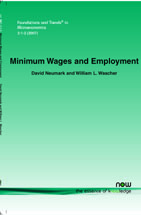Minimum Wages and Employment
By David Neumark, Department of Economics, 3151 Social Science Plaza, University of California-Irvine, USA, dneumark@uci.edu | William L. Wascher, Board of Governors of the Federal Reserve System, Division of Research and Statistics, USA, william.l.wascher@frb.gov
Abstract
We review the burgeoning literature on the employment effects of minimum wages – in the United States and in other countries – that was spurred by the new minimum wage research beginning in the early 1990s. Our review indicates that there is a wide range of existing estimates and, accordingly, a lack of consensus about the overall effects on low-wage employment of an increase in the minimum wage. However, the oft-stated assertion that recent research fails to support the conclusion that the minimum wage reduces employment of low-skilled workers is clearly incorrect. A sizable majority of the studies surveyed in this monograph give a relatively consistent (although not always statistically significant) indication of negative employment effects of minimum wages. In addition, among the papers we view as providing the most credible evidence, almost all point to negative employment effects, both for the United States as well as for many other countries. Two other important conclusions emerge from our review. First, we see very few – if any – studies that provide convincing evidence of positive employment effects of minimum wages, especially from those studies that focus on the broader groups (rather than a narrow industry) for which the competitive model generally predicts disemployment effects. Second, the studies that focus on the least-skilled groups that are likely most directly affected by minimum wage increases provide relatively overwhelming evidence of stronger disemployment effects for these groups.
Minimum Wages and Employment
Minimum Wages and Employment focuses on the "new minimum wage research." This is the first comprehensive review of the literature in the past fifteen years. It includes the initial round of the new minimum wage research on the employment effects of the minimum wage, major conceptual and empirical issues that arose out of that research, recent increases in minimum wage laws, and the empirical research on the employment effects of the minimum wage in other countries. Minimum Wages and Employment provides an assessment of alternative models of the labor market. It offers general conclusions about the effects of the minimum wage on employment that are relevant to policymakers, pointing out in what context and for which workers the minimum wage will have consequences. Finally, by presenting a comprehensive review of the more recent minimum wage literature, the authors explain the range of results in the literature, identify sources of differences in these results, and determine what conclusions can be drawn from the literature.
